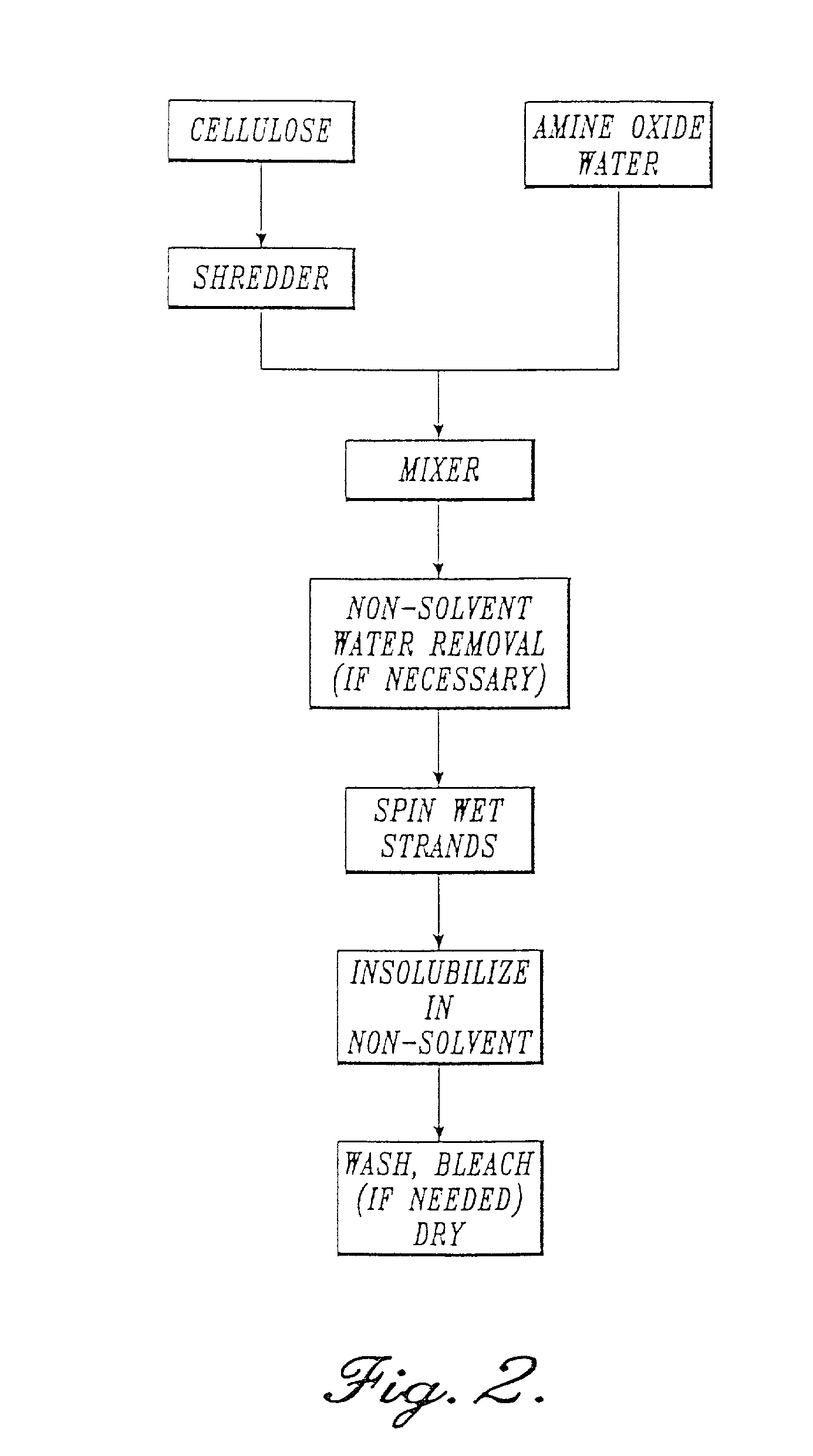Process for making a composition for conversion to lyocell fiber from an alkaline pulp having low average degree of polymerization values
a technology of alkaline pulp and composition, which is applied in the direction of melting methods, cellulosic plastic layered products, etc., can solve the problems of not being able to obtain acceptable quality dissolving pulps, significantly increasing the cost of lyocell fibers and products manufactured therefrom, and reducing the average degree of polymerization , the effect of reducing the hemicellulose conten
- Summary
- Abstract
- Description
- Claims
- Application Information
AI Technical Summary
Benefits of technology
Problems solved by technology
Method used
Image
Examples
example 1
[0082]Southern pine unbleached alkaline Kraft pulp with a kappa number of 26.4 (TAPPI Standard T236 cm-85 and a viscosity of 302 cp (TAPPI T230) (D.P. of 1593), a copper number of 0.6 and a hemicellulose content of 13.5%±2.0% was treated with oxygen in a pressure vessel with high consistency mixing capabilities. The mixture was stirred slowly for ten seconds every minute. The vessel had been preheated before pulp addition to about 90° C. An amount of sodium hydroxide (NaOH) equivalent to 100 pounds per ton of pulp was added to the alkaline pulp. The mixture was stirred for 20 seconds. The reaction vessel was then closed and the pressure was increased to 60 psig by introducing oxygen into the pressure vessel. The mixer was run for 60 minutes as described above. Water was present in the vessel in an amount sufficient to provide a 25% consistency.
[0083]After the 60 minutes, the stirring was stopped and the pulp was removed from the pressure vessel and washed. The resulting washed pulp ...
example 2
[0084]The procedure of Example 1 was repeated with the addition of hydrogen peroxide after the addition of sodium hydroxide. The pressure vessel was run for 60 minutes at a temperature of 115° C. The peroxide was added in an amount of 20 pounds per ton of pulp.
[0085]The treated pulp had a viscosity of 30 cp (D.P. 810), a copper number of 0.3, and a hemicellulose content of 13.5±2.0%. The pulp exhibited a kappa number of 7.0.
example 3
[0086]The treated pulp of Example 1 was bleached to determine the effect of bleaching on the D.P. of the treated pulp. The treated pulp of Example 1 was subjected to a DED bleaching sequence comprising a chlorine dioxide D1 stage, a sodium hydroxide / hydrogen peroxide E stage and a chlorine dioxide D2 stage.
D1 Stage
[0087]The D1 stage treated pulp processed in accordance with Example 1 by washing it three times with distilled water, pin fluffing the pulp, and then transferring the pulp to a polypropylene bag. The consistency of the pulp in the polypropylene bag was adjusted to ten percent with the addition of water. Chlorine dioxide corresponding to an amount equivalent to 28 pounds per ton of pulp was introduced to the diluted pulp by dissolving the chlorine dioxide in the water used to adjust the consistency of the pulp in the bag. The bag was sealed and mixed and then held at 65° C. for 15 minutes in a water bath. The pulp was removed and washed with deionized water.
E Stage
[0088]Th...
PUM
| Property | Measurement | Unit |
|---|---|---|
| Fraction | aaaaa | aaaaa |
| Fraction | aaaaa | aaaaa |
| Fraction | aaaaa | aaaaa |
Abstract
Description
Claims
Application Information
 Login to View More
Login to View More - R&D
- Intellectual Property
- Life Sciences
- Materials
- Tech Scout
- Unparalleled Data Quality
- Higher Quality Content
- 60% Fewer Hallucinations
Browse by: Latest US Patents, China's latest patents, Technical Efficacy Thesaurus, Application Domain, Technology Topic, Popular Technical Reports.
© 2025 PatSnap. All rights reserved.Legal|Privacy policy|Modern Slavery Act Transparency Statement|Sitemap|About US| Contact US: help@patsnap.com



